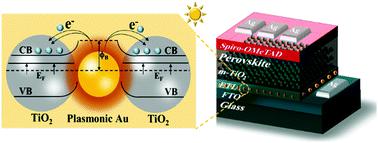当前位置:
X-MOL 学术
›
Energy Environ. Sci.
›
论文详情
Our official English website, www.x-mol.net, welcomes your
feedback! (Note: you will need to create a separate account there.)
Tailoring carrier dynamics in perovskite solar cells via precise dimension and architecture control and interfacial positioning of plasmonic nanoparticles
Energy & Environmental Science ( IF 32.4 ) Pub Date : 2020-02-19 , DOI: 10.1039/c9ee03937f Xun Cui 1, 2, 3, 4, 5 , Yihuang Chen 1, 2, 3 , Meng Zhang 1, 2, 3 , Yeu Wei Harn 1, 2, 3 , Jiabin Qi 1, 2, 3 , Likun Gao 1, 2, 3 , Zhong Lin Wang 1, 2, 3 , Jinsong Huang 3, 6, 7, 8 , Yingkui Yang 4, 5, 9, 10 , Zhiqun Lin 1, 2, 3
Energy & Environmental Science ( IF 32.4 ) Pub Date : 2020-02-19 , DOI: 10.1039/c9ee03937f Xun Cui 1, 2, 3, 4, 5 , Yihuang Chen 1, 2, 3 , Meng Zhang 1, 2, 3 , Yeu Wei Harn 1, 2, 3 , Jiabin Qi 1, 2, 3 , Likun Gao 1, 2, 3 , Zhong Lin Wang 1, 2, 3 , Jinsong Huang 3, 6, 7, 8 , Yingkui Yang 4, 5, 9, 10 , Zhiqun Lin 1, 2, 3
Affiliation

|
Placing plasmonic nanoparticles (NPs) in close proximity to semiconductor nanostructures renders effective tuning of the optoelectronic properties of semiconductors through the localized surface plasmon resonance (LSPR)-induced enhancement of light absorption and/or promotion of carrier transport. Herein, we report on, for the first time, the scrutiny of carrier dynamics of perovskite solar cells (PSCs) via sandwiching monodisperse plasmonic/dielectric core/shell NPs with systematically varied dielectric shell thickness yet fixed plasmonic core diameter within an electron transport layer (ETL). Specifically, a set of Au NPs with precisely controlled dimensions (i.e., fixed Au core diameter and tunable SiO2 shell thickness) and architectures (plain Au NPs and plasmonic/dielectric Au/SiO2 core/shell NPs) are first crafted by capitalizing on the star-like block copolymer nanoreactor strategy. Subsequently, these monodisperse NPs are sandwiched between the two consecutive TiO2 ETLs. Intriguingly, there exists a critical dielectric SiO2 shell thickness, below which hot electrons from the Au core are readily injected to TiO2 (i.e., hot electron transfer (HET)); this promotes local electron mobility in the TiO2 ETL, leading to improved charge transport and increased short-circuit current density (Jsc). It is also notable that the HET effect moves up the Fermi level of TiO2, resulting in an enhanced built-in potential and open-circuit voltage (Voc). Taken together, the PSCs constructed by employing a sandwich-like TiO2/Au NPs/TiO2 ETL exhibit both greatly enhanced Jsc and Voc, delivering champion PCEs of 18.81% and 19.42% in planar and mesostructured PSCs, respectively. As such, the judicious positioning of rationally designed monodisperse plasmonic NPs in the ETL affords effective tailoring of carrier dynamics, thereby providing a unique platform for developing high-performance PSCs.
中文翻译:

通过精确的尺寸和结构控制以及等离激元纳米粒子的界面定位来调节钙钛矿太阳能电池中的载流子动力学
将等离激元纳米粒子(NPs)放置在紧邻半导体纳米结构的位置,可通过局部表面等离振子共振(LSPR)诱导的光吸收增强和/或促进载流子传输来有效调节半导体的光电性能。在此,我们报告,对于第一次,钙钛矿太阳能电池(的PSCs)的载流子动力学的详细审查经由夹持单分散等离激元的电子传输层内/电介质芯/与系统地改变电介质壳的厚度壳的NP未定电浆纤芯直径( ETL)。具体来说,一组具有精确控制尺寸的Au NP(即,固定的Au核直径和可调的SiO 2壳厚度)和结构(纯金NP和等离激元/介电Au / SiO 2核/壳NP)首先通过利用星形嵌段共聚物纳米反应器策略来制作。随后,将这些单分散NP夹在两个连续的TiO 2 ETL之间。有趣的是,存在一个临界电介质SiO 2壳厚度,在该壳厚度以下,来自Au核的热电子很容易注入TiO 2中(即,热电子传递(HET))。这促进了TiO 2 ETL中的局部电子迁移率,从而改善了电荷传输并提高了短路电流密度(J sc)。还值得注意的是,HET效应使TiO 2的费米能级上升,导致内置电势和开路电压(V oc)增强。两者合计,通过使用类似三明治的TiO 2 / Au NPs / TiO 2 ETL构造的PSC表现出大大提高的J sc和V oc,在平面型和介观结构的PSC中分别提供18.81%和19.42%的冠军PCE。因此,在ETL中合理设计的单分散等离子体NP的明智定位可有效调整载流子动力学,从而为开发高性能PSC提供了独特的平台。
更新日期:2020-02-19
中文翻译:

通过精确的尺寸和结构控制以及等离激元纳米粒子的界面定位来调节钙钛矿太阳能电池中的载流子动力学
将等离激元纳米粒子(NPs)放置在紧邻半导体纳米结构的位置,可通过局部表面等离振子共振(LSPR)诱导的光吸收增强和/或促进载流子传输来有效调节半导体的光电性能。在此,我们报告,对于第一次,钙钛矿太阳能电池(的PSCs)的载流子动力学的详细审查经由夹持单分散等离激元的电子传输层内/电介质芯/与系统地改变电介质壳的厚度壳的NP未定电浆纤芯直径( ETL)。具体来说,一组具有精确控制尺寸的Au NP(即,固定的Au核直径和可调的SiO 2壳厚度)和结构(纯金NP和等离激元/介电Au / SiO 2核/壳NP)首先通过利用星形嵌段共聚物纳米反应器策略来制作。随后,将这些单分散NP夹在两个连续的TiO 2 ETL之间。有趣的是,存在一个临界电介质SiO 2壳厚度,在该壳厚度以下,来自Au核的热电子很容易注入TiO 2中(即,热电子传递(HET))。这促进了TiO 2 ETL中的局部电子迁移率,从而改善了电荷传输并提高了短路电流密度(J sc)。还值得注意的是,HET效应使TiO 2的费米能级上升,导致内置电势和开路电压(V oc)增强。两者合计,通过使用类似三明治的TiO 2 / Au NPs / TiO 2 ETL构造的PSC表现出大大提高的J sc和V oc,在平面型和介观结构的PSC中分别提供18.81%和19.42%的冠军PCE。因此,在ETL中合理设计的单分散等离子体NP的明智定位可有效调整载流子动力学,从而为开发高性能PSC提供了独特的平台。











































 京公网安备 11010802027423号
京公网安备 11010802027423号